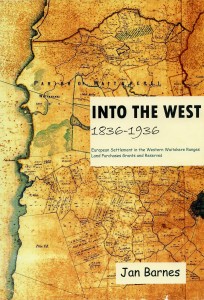 Into the West: a goldmine of information about the early settlers of the West
Into the West: a goldmine of information about the early settlers of the West
Piha resident, Jan Barnes, is a descendant of two of the oldest families to settle in the Waitakere Ranges. Edward Lovett, a shoe manufacturer from Leicestershire, and Sarah Usher farmed Edward’s Crown Grant in the upper Karekare Valley from1862. Their old house, near the Karekare turnoff, was a local landmark for years and there are tracks and streams in the Ranges named after the family. Sarah’s son, Thomas Ussher, married Augusta Brabazon, daughter of a teacher, Joseph Brabazon who had taken up land near the Nihotupu Stream. He built a house The Castle there and the now neglected Castle Track was cut as part of a failed tourism venture.
Jan grew up out on the Ussher farm at Piha, hearing these stories from her relatives. This sent her searching for more information and over many years she has exhaustively researched and documented the early European owners of land in the western Waitakeres. Now she has put it together in a simple monograph with maps, photographs of people and places, and tables of recipients of Crown Grants. Her research stretches from Bethells in the north to the Manukau Coast eastwards to Big Muddy Creek.
Some of the story of the settlement of this coast is well known to students of the history of the Coast ” the Gibbons’ family timber milling enterprises and the failed Cornwallis settlement – but much of what Jan tells us is new. Francis White, who gave his name to White’s Beach where he took up land, was a blacksmith, and hatched a scheme to mine iron sand. He had a sample successfully smelted by a local company and sent to England, but he lacked capital to get his venture off the ground and defaulted on all his mortgages. After a lull of 150 years, iron sand mining of the coast is once more being proposed, this time by the much more scarey extractor, the multinational, Rio Tinto.
When the Waitakeres were surveyed, Native Reserves were created at Piha, North Piha and Te Henga. In 1876 Dr William Stockwell leased the Piha reserves and moved his stepsons, Charles and Keith Cowan, down onto the flat land (today’s Domain) to run the property. Their grandmother, then aged 80, came out to look after them and, in a scene redolent of The Piano, was transported along the beach from Whatipu and then carried by the Cowan boys on their backs up the bridle track from Karekare.
Whenever Jan tells us about a landowner, we get a brief biography as well, and often a photo, so that the people come to life. Often, we learn the identity of a person behind a local place name.
Jan’s work makes clear that the settlement of the ranges was not just by husband and wife farmers. Land speculators and developers from the city had their eyes on the Ranges. Some of the names that crop up, like James Dilworth, are to be found acquiring land all over the region. While Jan gives a graphic picture of the harsh life of the early settlers, some never left town. Joseph Greenwood, for example, an ex-Fencible soldier, bought and was granted hundreds of acres on both sides of Big Muddy Creek. But he had other properties, a townhouse in Emily Place and a 500-acre estate at Mangere called Ascot. Greenwood kept racehorses and was a member of Parliament.
Anyone with an interest in the early history of the area will find this fascinating study a valuable resource. It costs $25 and is available from Murray Gray’s Gone West bookshop, Arataki Visitor Centre and the West Coast Gallery. Or phone 8128499.
Sandra Coney


